Understanding the Mechanics of Barreling Waves in Surfing
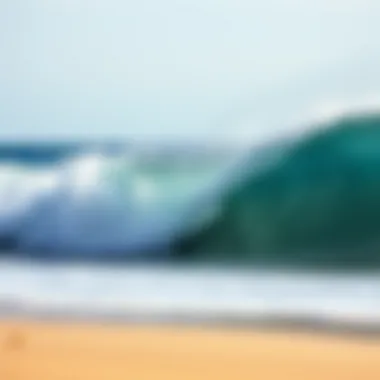
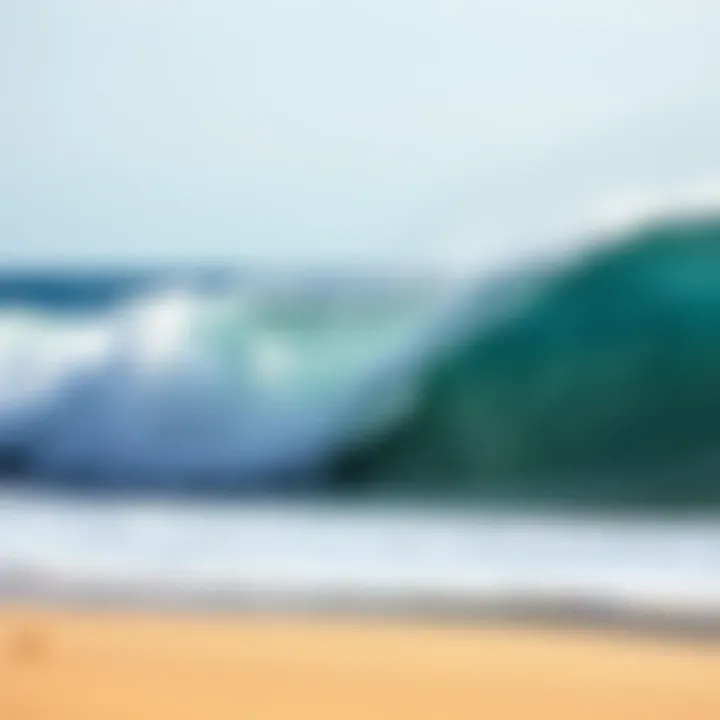
Intro
Waves possess a unique charm, and none captures the imagination quite like barreling waves. These towering, hollow surf forms roll towards the shore, creating a captivating spectacle not only for surfers but for anyone who has a heart for the ocean. Understanding the dynamics of barreling waves is more than just an academic pursuit; it holds practical implications for surfers seeking the thrill of perfect rides. As we plunge into this topic, we will explore the science behind how these waves develop, the ideal conditions for their formation, and the various factors influencing their performance.
Recognizing the nuances of barreling waves extends far beyond mere admiration. It involves appreciating the intricate relationship between ocean currents, wind conditions, and tide cycles. For surfers, these elements are of great importance, as they determine the suitability and the challenge a wave presents. Additionally, knowing how to navigate a barreling wave safely heightens the enjoyment and reduces risks associated with this exhilarating activity. Whether you are a newbie looking to catch your first barrel or an old pro looking to refine your skills, this exploration serves as a treasured guide.
The upcoming sections will not only give you tips and techniques tailored to your current skill level but also review essential gear for maximizing your experience in the water. Beyond techniques, we will take a closer look at the cultural significance of barreling waves in the surfing community – from legendary surf spots to iconic moments that define surfing history. We’ll make those essential connections, aiming to enhance each reader's understanding and appreciation of this mesmerizing ocean phenomenon.
Understanding Barreling Waves
Barreling waves represent a crucial aspect of surfing that captivates both enthusiasts and professionals alike. Understanding these waves is fundamental to grasping the dynamics of surfing. Barreling waves, characterized by their hollow form, present an exciting challenge and opportunity for surfers to showcase their skills. They aren't just mere spectacle; their formation and behavior are deeply tied to a variety of factors including oceanographic, meteorological, and geological influences.
The significance of barreling waves lies in their interplay with surfing culture. For many, catching a barrel is the epitome of the surfing experience. Surfers chase these waves not just for the thrill they bring but for the connection they foster with nature. Unraveling the essence of barreling waves contributes positively to the sport’s community and its growth.
Knowledge of barreling waves enhances safety and technique, both vital for anyone looking to ride these monumental waves. By delving into their definitions, physics, and types, surfers become equipped to navigate the oceans more wisely. This understanding can transform an ordinary surfing ride into an extraordinary adventure, minimizing risk while maximizing enjoyment.
Definition of Barreling Waves
Barreling waves occur when a wave breaks over a shallow seabed, creating a hollow, tube-like structure. This phenomenon is often described as a wave that curls over itself. The defining characteristic of a barreling wave is its ability to form a cylindrical shell of water that stands tall enough for surfers to ride through the center as it breaks.
In many cases, barreling waves manifest at specific geographic spots known for their reef or point breaks, where underwater formations guide the wave's journey ashore. These waves are not just distinguished by their shape; their energy and speed also set them apart as one of the most thrilling types of waves to surf.
Physics of Wave Formation
Wave Energy
Wave energy is the driving force behind the creation of barreling waves. It refers to the energy transferred from the wind as it interacts with the water's surface, generating waves. The key characteristic of wave energy lies in its ability to store and release kinetic energy when waves propagate toward the shore. This energy is fundamental for surfers wanting to catch waves, as it directly influences wave height, speed, and ultimately, the surfable nature of the wave.
The unique feature of wave energy in the context of barreling waves is that it varies with wind speed and direction, water depth, and coastal topography. High-energy conditions often result in steeper and faster waves, making them ideal for barreling. However, it also brings challenges, as powerful waves can pose greater risks for surfers attempting to navigate their pipes.
Breaking Waves Dynamics
Breaking waves dynamics involve the process of a wave losing its energy as it approaches the shore, leading to various forms of breakages. Understanding how waves break is essential because it determines how barreling waves develop, what shapes they take, and how they behave. A significant aspect of this is the weight distribution of water, which affects the wave's momentum.
The key here is that the energy becomes concentrated as the wave rises, creating steep faces and the potential for hollow tubes. This makes barreling waves not only a joyride for surfers but also a lesson in physics for those keen to understand what drives these phenomena.
The dynamics of breaking waves can be distinctly observed in surf conditions, informing surfers where to catch the best waves. However, it is this same power that can create hazardous conditions if they are not respected.
Types of Barrel Waves
A variety of wave types exists, each showcasing unique conditions suitable for barreling. The regional characteristics influence not only the height and shape of these waves but also the experience of the surfers who engage with them.
Beach Breaks
Beach breaks occur where waves crash over sandy bottoms, often leading to unpredictable breaks. These are frequently favored by beginners due to their accessibility and gentle conditions. However, the sandy base can be unpredictable, leading to changes in wave shape and surfability.
The key characteristic of beach breaks is their variability; they can produce both mellow and challenging barrels depending on the swell direction and tide. This can either be advantageous for honing skill or a disadvantage due to variable conditions that require quick adaptability.
Point Breaks
Point breaks occur when waves break over a point of land, creating longer rideable sections, known for their predictability. These breaks often form perfect barrels, making them a popular choice among experienced surfers looking for reliable conditions.
The unique feature of point breaks is that they allow multiple surfers to ride the same wave, providing longer rides and beautiful, lined-up barrels. However, they do require a sharp understanding of positioning, as strong competition can arise.
Reef Breaks
Reef breaks are associated with waves breaking over coral reefs or rocky seabeds. These locations typically yield powerful, sharp barrels, favored by advanced surfers wanting a thrilling experience. The key characteristic of these breaks is their unforgiving nature; many shallow reefs can lead to wipeouts that result in injury if the surfer is not cautious.
Visiting a reef break often involves a greater risk versus reward scenario, where the allure of a perfect barrel may also lead to harsh consequences due to their formidable strength and potential hazards posed by the underlying reef.
Conditions Favoring Barreling Waves
Understanding the factors that create barreling waves is essential for both surfers and enthusiasts. These waves don’t just appear out of thin air; various conditions come into play to foster their formation. From seasonal influences to geographical characteristics, each aspect contributes to the quality and behavior of waves. Knowing these conditions can lead to better surfing experiences and a deeper appreciation for the ocean's dynamics.
Seasonal and Climatic Influences
Storm Swells
Storm swells occur from intense weather systems, like hurricanes or cyclones. They generate massive winds that travel long distances across the ocean. One key characteristic of storm swells is their ability to create powerful waves, which can break along coastlines, resulting in ideal barreling conditions.
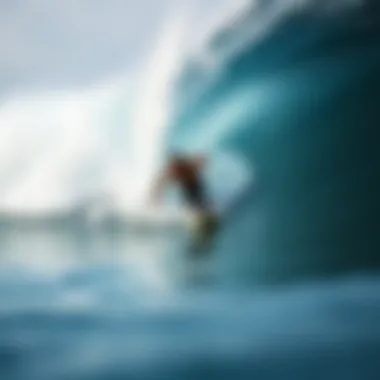
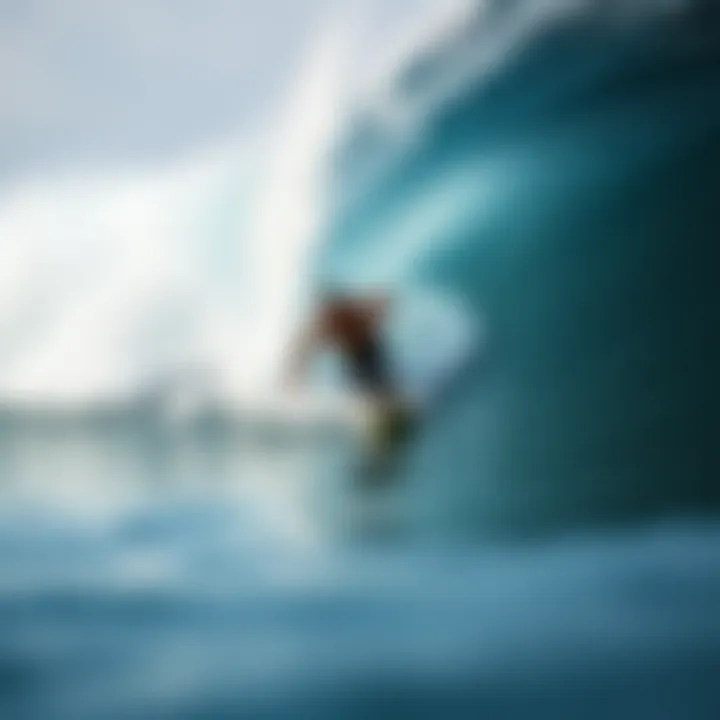
These swells are often a surfer’s paradise. The unique feature of such swells is how they magnify the energy of the waves, making them much more potent than regular wind swells. The downside is that these conditions can also lead to dangerous and unpredictable waves. Surfers need to have a keen understanding of the risks involved when chasing such swells. The excitement of riding a monster wave can easily turn into a perilous situation if one is not prepared.
Wind Patterns
Wind patterns play a crucial role in shaping barreling waves. A favorable offshore wind aligns perfectly with incoming swells to create smooth, hollow waves. The main characteristic of these winds is their direction and strength, which determines the quality of the wave’s formation.
Good wind conditions can enhance wave shape and create the perfect barrel. The unique aspect of wind patterns is their variability; they can change rapidly based on local meteorological conditions. Surf spots that benefit from consistent offshore winds become go-to places for surfers aiming to catch the best barrels. However, on the flip side, sudden changes in wind direction can ruin wave quality, so surfers must keep a close eye on the weather.
Geographical Considerations
Coastal Topography
Coastal topography significantly impacts how barreling waves form. The shape of the coastline—whether it’s a sandy beach or a rocky point—directly influences wave behavior. A key characteristic of coastal topography is its ability to direct the wave energy towards a specific point, enhancing the potential for barreling.
Unique coastal formations, like points and reefs, can amplify waves. These features can create more consistent and favorable conditions for barreling. However, rocky outcrops may also present a hazard for surfers due to potential collisions, highlighting the importance of knowing one’s environment before paddling out.
Ocean Floor Composition
The composition of the ocean floor, or bathymetry, is another vital factor influencing barreling waves. Different textures, like sand, rock, or coral, can drastically change how waves break. One key characteristic here is how hard surfaces tend to create steeper and faster waves, leading to better barrel formations.
An interesting feature of ocean floor composition is that it can vary widely even over short distances, causing waves to behave very differently depending on local conditions. For instance, a sandy bottom might lead to more forgiving waves, while rocky reefs could produce sharper, more challenging barrels. Understanding these dynamics helps surfers select the right spots based on their skill levels and preferences.
Tidal Impact on Wave Behavior
The tide can have a major effect on wave behavior and barreling potential. As the tide rises and falls, it changes the depth of water over reefs or sandbars, which can influence how and when waves break. Surfers often learn to read the tides, as certain tidal conditions can result in more favorable barrels.
Thus, understanding how the tide works can help surfers maximize their experience while minimizing risks. From assessing the best times to surf to preparing for varying wave conditions, tidal knowledge is key to unlocking an optimal surfing experience.
Navigating Barreling Waves
Navigating barreling waves is not just about riding the tide; it’s about mastering the elements. For both seasoned surfers and beginners, understanding the nuances of these powerful waves can set the tone for an exhilarating day on the water. This part of the article highlights core techniques, advanced moves, and critical safety tips that can turn a challenging surf session into a remarkable one.
Technique Fundamentals
Paddling Strategy
Paddling strategy plays a pivotal role when it comes to getting into the perfect position for barreling waves. It's not just about how fast you paddle; it’s about being smart with your effort. Key to effective paddling is timing. You have to synchronize your strokes with the wave's approach. This means that when you spot a wave, you must start paddling hard when it's still a bit far out.
A significant characteristic of a successful paddling strategy is maintaining a relaxed body position while maximizing your power. Keep your legs extended behind you in a streamlined position to reduce drag and help with faster movement. The strategic angle of your body also helps; a slight tilt towards the wave can increase your chances of catching it as it rises underneath you.
Positioning on the Wave
Positioning on the wave is where many surfers either shine or falter. This involves not just where the wave is peaking but also how you plan to ride it. Being in the right spot is paramount; if you’re too far back, the wave may pass you by, and if you are too far forward, the risk of getting caught in the whitewater increases.
An essential aspect of positioning involves understanding the wave’s makeup. Each wave breaks differently based on the type of reef or sandbar. Adding to that, a unique feature of positioning in barreling waves is learning to read the water and the swell pattern. Pay attention to the swell direction, and position yourself to take advantage of those fast-moving waves. This nuanced understanding provides a significant advantage, as it allows for more controlled and thrilling rides.
Advanced Maneuvers
Tube Riding Techniques
One of the most exhilarating parts about barreling waves is the ability to ride inside the tube. Tube riding techniques encompass specific skills that can take time to master. Key characteristics here are timing and reflexes. You have to drop into the wave just before it begins to hollow out and curl over.
This unique feature of tube riding is that it offers a thrilling experience unlike any other. The sound of crashing water, the rush of air as you zip through the barrel, creates an adrenaline surge that many surfers live for. However, it's crucial to know that entering the barrel requires skill and practice and can sometimes lead to wipeouts if miscalculated. Knowledge of how to handle your board while in the tube drastically enhances your overall experience and safety.
Exiting the Barrel
Exiting the barrel is just as important as getting in. It’s the moment that separates a novice from an expert. Knowing your exit point is crucial — miscalculating could send you tumbling in the surf. When you're in that tight spot, the key is to stay relaxed and not panic. The more you tense up, the harder it becomes to steer your board effectively.
A significant characteristic of a proper exit involves gauging the wave's speed and curvature. You need to feel when to redirect your board and speed up for an exit. This advanced maneuver is all about reading the wave's behavior just as much as it is about technique. Understanding where to land as you come back out can elevate your experience, while also ensuring your safety.
Safety Considerations
Recognizing Hazards
Being aware of your surroundings in the water is vital for anyone looking to ride barreling waves. Recognizing hazards, such as rocky bottoms, strong rip currents, or sudden changes in wave patterns, can make or break a surfing session. An essential characteristic to look out for is the color of the water; murky water often indicates poor visibility and potentially dangerous situations beneath the surface.
A unique aspect of recognizing hazards is the need for constant situational awareness. A moment of distraction can lead to unfortunate encounters with a hidden rock or fellow surfers. Resourceful surfers often scout out a surfing location before they even get in the water, asking locals about any potential dangers and using that information to navigate effectively.
Using Proper Gear
Using proper gear cannot be overstated, especially in challenging wave conditions. A well-fitted wetsuit can keep you warm in colder waters, while the right board can provide significant control and comfort. An important characteristic of proper gear is its ability to enhance your overall experience by offering support and minimizing injury risk.


A unique feature of using the right surfing equipment involves tailoring your choices to the specific wave conditions you’ll encounter. Generally, for barreling waves, shorter boards often provide more maneuverability, while thicker boards may offer greater stability. Not only does this distinction matter in performance, but it also plays a considerable role in safety. Understanding the intricacies of your gear can make all the difference in keeping your surfing experience as thrilling yet secure as possible.
Remember, it’s not just about riding the wave but mastering it.
Navigating barreling waves requires a blend of technique, awareness, and gear. By breaking down each component's significance, surfers can build a deeper understanding of what it takes to conquer these magnificent waves. Whether you’re honing your paddling skills or perfecting tube riding techniques, safety should always reign supreme.
Gear for Riding Barreling Waves
Having the right gear can make all the difference when riding barreling waves. Surfers might boast about their skills, but it's no secret that the equipment they use plays a crucial role in their experience on the water. Depending on various factors, including wave size and personal preference, selecting the right surfboard, wetsuit, and associated gear is essential for both performance and enjoyment.
Surfboard Selection
Shortboards vs Longboards
When it comes to choosing between shortboards and longboards, both have their own merits, yet for barreling waves, shortboards often steal the spotlight. These boards tend to be more maneuverable, which is particularly advantageous when navigating the tight spaces within a barrel. The light weight and shorter length allow for quick turns and fast paddling, perfect for catching those steep, powerful waves. However, they can be more challenging for beginners, requiring honed skills and experience to handle effectively.
On the flip side, longboards offer stability and ease of riding. They provide a different surfing experience and can be great for mellow surf where the wave isn't too steep. While less suited to tight barrels, they certainly have their place in the surfing world.
- Shortboards: Quick and agile, ideal for riding the curl.
- Longboards: Stable and easy, often better for beginner surf.
Shapes Optimal for Barrel Waves
When considering shapes optimal for barrel waves, it's essential to note that narrower tails and more pronounced rocker lines are hallmarks of designs meant for deep tubes. A board with a snug fit allows for better control, especially as one angles into the wave's hollow section. Typical outlines like a tapered nose or a rounded pin tail can aid in both speed and relinquishing a surfer's drag factor.
Surfers often find that a board tailored to barrel riding can be the edge in contests or even the difference in simply enjoying the ride. A short, agile board lets them drop in quickly and maintain speed, which is vital inside the barrel.
- Narrow tails: Enhance control in tight spaces.
- Rocker profile: A low rocker promotes speed, while a high rocker helps with maneuverability.
Wetsuit and Equipment
Material and Thickness Considerations
Wetsuits come in various materials and thicknesses, and these factors are crucial for surfers braving the colder water often found at the best barrel spots. A suit that’s too thin won’t keep a surfer warm, while one that's too thick can feel restrictive and impede movement. Generally, a thickness between 3/2mm and 4/3mm is ideal for moderate to cold waters.
Neoprene remains a popular choice because of its flexibility and durability. The right wetsuit allows surfers to comfortably ride all day, free from the chilling effects of the sea. Although the price may be higher on premium suits, such investments frequently result in more enjoyable hours spent in the water.
- Flexibility: Essential for paddling and movement.
- Insulation: Retains body heat to ward off cold.
Accessories for Comfort
Accessories play a vital role in enhancing a surfer's overall experience on barreling waves. Items like surf booties, gloves, and hoods can protect against icy waters and rough surfaces. These essentials not only help in comfort and warmth but also provide grip, which is critical while paddling out or riding.
Also, consider anti-chafing products or rash guards to prevent skin irritations from prolonged exposure. The right accessories keep a surfer comfortable and focused on the waves.
- Booties and gloves: Provide warmth and grip in colder waters.
- Rash guards: Prevent skin irritations and are great for extra sun protection.
Investing in high-quality gear may seem pricey initially, but it pays off by enhancing performance and safety while riding barreling waves.
Cultural Significance of Barreling Waves
Understanding the cultural significance of barreling waves can truly illuminate the bond that surfers share with the ocean. These waves are not just a thrill-seeking opportunity; they represent a deeper connection to nature, history, and community. Beyond the adrenaline rush provided by catching a barreling wave, these swells act as a beacon that draws individuals into a world rich with tradition and shared experiences. The cultural landscape shaped by barreling waves speaks to the values of respect, conservation, and the lifestyle embraced by surfers.
Barreling Waves in Surf Culture
Iconic Surf Spots
When talking about iconic surf spots, places like Pipeline in Oahu or Teahupo'o in Tahiti spring to mind. These locations exemplify the spirit of barreling waves and why they hold a revered status among surfers. Pipeline, known for its powerful waves that create perfect barrels, attracts surfers from all over the globe. The intense energy and impressive beauty of these waves present both a challenge and a celebrated experience.
The allure of these iconic spots is twofold: not only are they known for phenomenal surfing conditions, but they also provide a sense of community. Surfers gather to share stories, techniques, and experiences—creating a collective memory that defines surf culture. However, these popular locations can become overcrowded, leading to competition and stress among surfers who seek the perfect ride.
Cinematic Representation
Cinematic representation has played a pivotal role in elevating the cultural significance of barreling waves. Films such as "Riding Giants" and "Step Into Liquid" capture the electrifying spirit of surf culture in a way that resonates with both surfers and non-surfers alike. These films not only showcase breathtaking stunts and rides but also delve into the lives of surfers and the challenges they face.
The strong visual storytelling inherent in these films contributes to a wider appreciation for barreling waves and the communities that revolve around them. Moreover, it has fostered a sense of responsibility among viewers to respect and conserve these natural wonders, making cinematic representation an essential aspect of surf culture. However, the dramatization of some events can lead to misconceptions about the sport and the waves themselves.
Community and Competition
Events Focused on Barreling Waves
Events like the Billabong Pipe Masters demonstrate how barreling waves cultivate competitive spirit and camaraderie in surf culture. These contests, set against the backdrop of Hawaii's famous waves, highlight not just individual prowess but also the unity among participants. Competitions serve as proving grounds for both seasoned pros and enthusiastic amateurs, where they can showcase their skills in front of judges and fellow surfers.

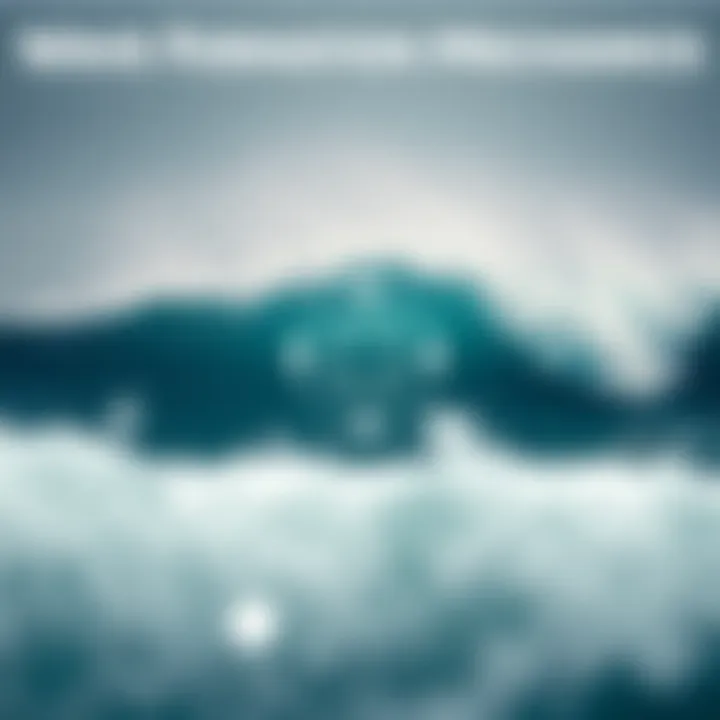
Events focused on barreling waves also encourage the sharing of knowledge and techniques, as participants often gather to discuss strategies and wave dynamics. This fosters a sense of community while driving the competitive nature of the sport. However, the pressure to perform can sometimes overshadow the primary joy of surfing for some competitors.
Surfer Communities and Connections
Surfer communities form an intricate web of friendships, support, and shared experiences. Whether it's a local surf shop or a beachside gathering spot, these connections become vital in cultivating the experience of riding barreling waves. Local knowledge of surf conditions, tides, and techniques is often passed down through these communities, creating a strong bond that is cherished by all.
Surfer communities also worry about issues like ocean pollution and conservation efforts, advocating for a sustainable future. The unique feature of these communities is that they often serve as both a social network and a platform for activism. However, the challenge lies in maintaining inclusiveness, as some new surfers feel intimidated by established members.
"In surfing, we find not just a sport but a culture—a universal language that connects us all, no matter our background."
In wrapping up this section, it’s clear that barreling waves are not merely the playground of a select few; they are woven into the very fabric of surf culture. The appreciation of these waves transcends individual surfing experiences, constituting a rich tapestry of community, competition, and cultural expression.
Environmental Impact and Conservation
The relationship between barreling waves and the environment is a significant area of concern for both surfers and conservationists. Understanding how these powerful natural phenomena interact with our ecosystems is vital not only for preserving the waves we cherish but also for ensuring the health of the coastal environments they inhabit. Conservation efforts in surfing communities are essential for maintaining the integrity of our ocean ecosystems while promoting sustainable surfing practices.
Impact of Climate Change on Wave Patterns
Climate change has a profound effect on ocean conditions, which in turn influences wave behavior. As global temperatures rise, ocean waters warm, leading to alterations in wave patterns and intensities. Research indicates that we may encounter more frequent severe storms, affecting the swell generation. This could lead to inconsistent barreling waves, particularly at spots renowned for their robust surf conditions.
In addition to storm intensification, rising sea levels may alter coastal topography, influencing how waves break and the availability of surfable conditions. Changes in water salinity and temperature can disrupt marine ecosystems, potentially impacting the aquatic life surfers rely on for a rich and healthy ocean environment.
"The future of barreling waves hinges upon our understanding of these climate-induced changes and our collective efforts to mitigate them."
Conservation Efforts in Surfing Communities
Surfing communities around the world have taken significant steps in promoting conservation initiatives aimed at protecting the surf environments. These grassroots movements stem from a shared love of the ocean and a desire to preserve it for future generations. Two essential aspects of these efforts are local initiatives and global movements.
Local Initiatives
Local initiatives often focus on specific environmental challenges faced by individual surf breaks. Programs may involve local surfers organizing beach clean-ups, advocating for policies that protect coastal ecosystems, or engaging in habitat restoration projects.
A key characteristic of local initiatives is that they tend to operate on a community level. This grassroots approach not only fosters a sense of stewardship among surfers but also enhances the visibility of local issues, encouraging others to get involved. For example, if a surf spot is littered with debris, local surfers might rally to clean it up, which not only improves conditions for surfing but also benefits ocean life.
The unique feature of these initiatives is their adaptability; they can be tailored to specific environmental issues or community needs. Local efforts tend to unite surfers in a common cause while bringing attention to the importance of environmental protection in surfing culture.
Global Movements
On a larger scale, global movements focus on issues that transcend local borders, addressing widespread concerns such as ocean pollution or climate action. Organizations like Surfrider Foundation and Save the Waves Coalition mobilize surfers globally to tackle pressing environmental challenges affecting coastlines.
A key characteristic of global movements is their ability to harness the collective power of surfers across the world. They implement campaigns to protect iconic surf spots and advocate for policy changes on an international level. For instance, they might lobby for marine protected areas to sustain the underwater habitats crucial to offshore wave dynamics.
The unique aspect of global movements is their emphasis on cooperation and education. They provide resources and platforms for surfers to engage in conservation, amplifying the voices of surfers who are passionate about protecting the ocean. However, the challenge remains when translating global strategies to effective local actions, making it critical for these movements to partner with local efforts.
The Future of Barreling Waves
As we look ahead, the fascination with barreling waves continues to capture the imagination of surfers and ocean enthusiasts alike. In a world facing rapid environmental changes, understanding the future dynamics of these captivating waves becomes crucial. The interplay of climate change, advancing technologies, and conservation efforts will inevitably shape the waves we ride and revere.
Research Directions on Wave Dynamics
In the continuing quest to understand barreling waves, researchers are venturing into new territories of science. The study of wave dynamics has expanded significantly, with a focus on various aspects:
- Modeling Coastal Behavior: Sophisticated computational models are helping to predict how waves interact with coastal environments under different climatic scenarios. These models can simulate various conditions, providing insights that could guide coastal management and surf culture.
- Wave Energy Harvesting: There's growing interest in harnessing the energy from barreling waves to sustainably power coastal communities. Research is focused on designing innovative systems that can convert wave energy into electricity without disrupting the natural wave patterns.
- Impact of Coastal Development: Examining how urbanization and infrastructure impact wave behavior is drawing attention. Changes in coastal topography can influence wave energy and shape, making it a critical area of study for preserving surfing spots.
Technological Advances in Surfing
With technology advancing at a rapid pace, substantial changes are being made to the surfing experience, especially concerning barreling waves. This encompasses various innovations:
Wave Pools and Artificial Surfing
Wave pools have revolutionized how surfers interact with barreling waves, providing a controlled environment to hone skills. These facilities generate perfect waves, making it easier for beginners while allowing seasoned surfers to practice complex maneuvers.
- Key Characteristics: Wave pools mimic natural wave behavior, allowing surfers to experience barreling conditions without the unpredictability of the ocean. This predictability is beneficial for training and competition.
- Unique Features: Some wave pools use specialized technology to create different types of waves, from gentle rollers to powerful barrels. This variety caters to diverse skill levels, making surfing accessible to many.
"Wave pools are changing the game; you can try angles and techniques you'd never dare in the ocean!"
However, while wave pools offer unique training opportunities, they face criticism regarding their environmental impacts and high operational costs, leading to a balance between innovation and sustainability.
Sustainable Surf Technologies
Amid discussions of environmental responsibility, sustainable surf technologies are at the forefront of modern surfing gear development. This growing domain focuses on reducing ecological footprints while maintaining performance.
- Key Characteristics: Many new surfboards are being produced using eco-friendly materials. Innovations include recyclable polystyrene, bio-resins, and sustainable wood sources, allowing surfers to enjoy their passion without adding to environmental degradation.
- Unique Features: These materials not only reduce harmful emissions but also often enhance the boards' performance. By sourcing materials locally, manufacturers can also cut down on transportation emissions, making this a compelling choice for eco-conscious surfers.
It's crucial to note that while advancements in sustainable surf technologies are paving the way toward greener surfing, challenges remain. The transition to fully sustainable production methods is ongoing and may face hurdles, including cost and availability.
In summation, the future of barreling waves holds both promise and concern. As technology and science converge, they will influence not only how we surf but also how we engage with and preserve our oceans. Understanding these aspects opens the door to both thrilling experiences and responsible stewardship of our natural resources.



